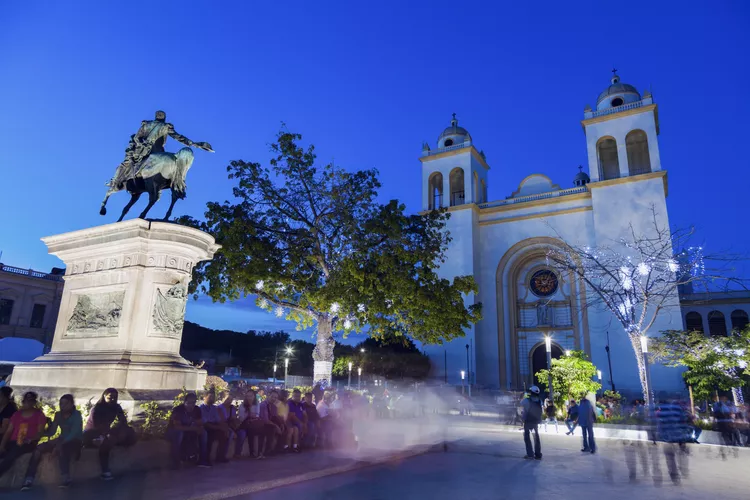San Salvador, the capital of El Salvador, is the second largest city in Central America (after Guatemala City in Guatemala), home to an entire third of the El Salvador population.
As a result, San Salvador contains affluent suburbs as well as slums, representing the discrepancy in the country’s distribution of wealth. Still recovering from an extended history of violence, San Salvador can be sprawling, grimy, and chaotic. However, once compromising first impressions are set aside, many travelers discover San Salvador’s other side: friendly, globe-conscious, cultured — even sophisticated.
Overview
San Salvador is located at the foot of the San Salvador Volcano in El Salvador’s Valle de las Hamazas – the Valley of the Hammocks – named for its powerful seismic activity. Though the city of San Salvador was founded back in 1525, the majority of its historic buildings have collapsed over the years due to earthquakes.
Moreover, San Salvador is one of the major transportation hubs of Central America; the capital city is spliced by the Pan-American Highway and is home to the largest and most modern Central America airport, El Salvador International.
What to Do
For the middle class, the wealthy, and international travelers, San Salvador’s attractions are as cosmopolitan as those of any Latin American city.
- Shopping in San Salvador: San Salvador is renowned for its modern shopping malls, boasting more than any other city in Central America. Notable shopping malls include Multiplaza, Galerias, Metrocentro, Moma Linsa, Ka Gran Via, and El Paseo. The Ilopango marketplace east of the city center is the best place to shop for crafts and goods from local artisans, along with the Mercado de Artesanías near Zona Rosa.
- San Salvador Beaches: It may surprise you, but there aren’t any beaches within San Salvador itself. The most popular beaches in El Salvador are located at La Libertad, just half an hour from the city.
- Nightlife in San Salvador: The Zona Rosa is the top destination for upscale nightlife. Popular spots include La Luna Casa y Arte, Senor Frog’s, Stanza, Guadalajara Grill, and Club Code. Make sure to take a taxi to and from your lodging at night for safety.
- San Salvador Museums & Historic Attractions: Among the best museums are the David J Guzman National Museum of Anthropology, the Museo de la Palabra y la Imagen (the Word and the Image Museum), and the Museo de Arte MARTE. Any cultural trip through San Salvador must also include the National Theater, the National Palace, and the National Cathedral.
Finally, the beautiful San Salvador Jardin Botánico La Laguna — the La Laguna Botanical Gardens — is a must-see for nature lovers.
When to Go
As with most Central American destinations, San Salvador experiences two major seasons: wet and dry. The wet season occurs from May to October, while the dry season is present before and after this period.
During Christmas, New Year’s, and Easter week (Semana Santa), San Salvador becomes extremely busy, crowded, and expensive. Nevertheless, the joyful throngs provide a vibrant atmosphere that is truly a sight to behold.
Getting There and Around
Getting to and around San Salvador is straightforward. Central America’s largest airport, El Salvador International Airport or “Comalapa,” is located right outside the city. The Pan American highway runs directly through San Salvador, linking it to Managua, Nicaragua, and San Jose, as well as Costa Rica to the south, and Guatemala City to the north, extending through North America. For overland travel between Central American countries, international bus lines Ticabus and Nicabus operate from terminals in San Salvador.
For budget-conscious travelers, the public bus system in San Salvador is decent and is the most affordable mode of transportation. Taxis are readily available, but it’s advisable to negotiate a fare before getting into the cab. Renting a car from a local agency, such as Hertz or Budget, is also an option for greater flexibility.
Tips and Practicalities
El Salvador is internationally known for its gang problems, with most gang activity centered in San Salvador. Consequently, crime can be a concern, particularly in poorer neighborhoods.
When visiting San Salvador, employ the same precautions you would in any Central American urban area: avoid displaying valuables; keep money and essential documents secure in a money belt or hotel safe; and refrain from walking alone at night – opt for a licensed taxi. Always prioritize your safety.
El Salvador has adopted the US dollar as its national currency, eliminating the need for American travelers to exchange money.
Fun Fact
The super-modern Metrocentro Mall in San Salvador is not only the largest shopping mall of the Metrocentro chain (which also owns malls in Tegucigalpa, Guatemala City, and Managua) but it is also the largest shopping mall in Central America.





